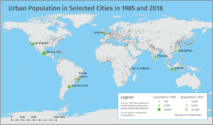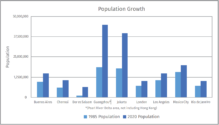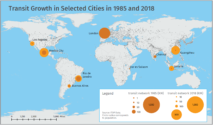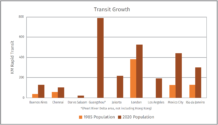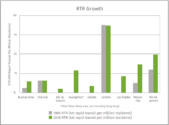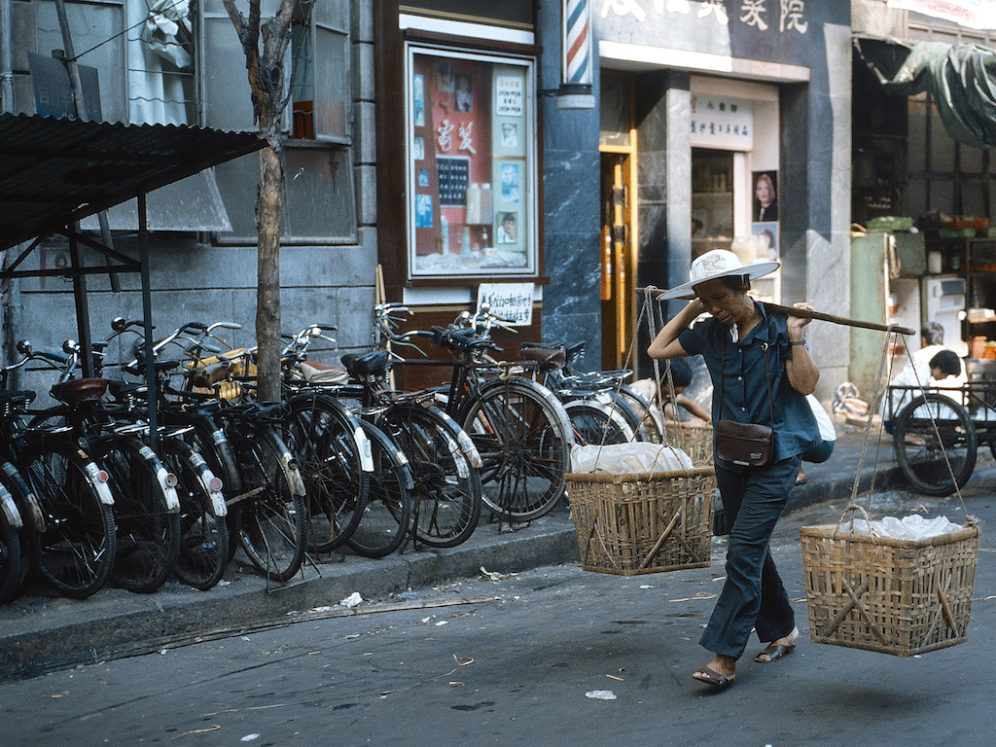
May 01, 2020
35 Years of Certain Change in an Uncertain World
Today, May 1, is a day full of meaning. Although some know it as May Day, a celebration of spring in the northern hemisphere, it is better known as International Workers Day. Here at ITDP, May 1 is the day when, exactly 35 years ago, ITDP founder Michael Replogle and a group of antiwar and mobility activists incorporated The Institute for Transportation & Development Policy. ITDP grew out of Bikes Not Bombs, then a humanitarian program to bring bikes to teachers and healthcare workers in Nicaragua, in defiance of the Reagan administration’s bombing campaign. What started with 100 bikes, quickly grew to 10,000, and moved beyond Nicaragua to Haiti and Mozambique. In the following years, ITDP began to think bigger, with efforts to reform the transport policies of both the World Bank and the US government.
In this moment of global crisis, our city systems are being tested like never before. Amid the uncertainly, one thing is clear: our cities will change. We know this because cities have always been at the forefront of change, and always will be. It was Heraclitus, a resident of the ancient city of Ephesus, circa 500 BC, in what is now Turkey, who famously observed, “The only thing that is constant is change.” 2500 years later, the sentiment is more relevant than ever.
The last 35 years have seen dramatic, fundamental change in cities around the world. In 1980, these city residents could not have imagined how different their cities would look in 35 years, just as we can’t imagine our cities 35 years from now. In honor of our 35th anniversary, ITDP selected nine world cities, and compared population and transit growth then and now.
Some cities have made incredible progress, providing quality transit options for more of their populations, while others have fallen behind. Some have embraced cycling, walking, and transit, while others are just starting to regulate private cars. What is clear, is that cities are shaped not by random acts of nature, but by the deliberate priorities, policies, and political will of decisive moments. We are in such a moment now. How these cities, and your own, will grow and change in the next 35 years is up to all of us.
To explore change over time, we took a snapshot of nine key cities 35 years ago and today, and looked at how their populations and transport systems have evolved. For better or worse, the change has been striking. ITDP has had partnerships with each of these cities, some with ITDP offices and decades of technical assistance, and others as best practice study tours and former winners of the Sustainable Transport Award.
Our World’s Cities: 1985 and Today
Population Growth in Select Cities between 1985 and Today
Click images to enlarge
Over the past 35 years, the world’s population has grown by more than 50% while urbanization has gone up over 30%. These trends, growing populations and growing cities, will not abate. In 35 years, our world and our cities have transformed. With so much growth, cities will have to harness tools to create livable cities.
Transit Growth in Select Cities between 1985 and Today
Click images to enlarge
Kilometers of rapid transit have increased worldwide. While this is important growth, more can be done to serve urban residents with sustainable transportation options. The next 35 years need to be dedicated to the the expansion and construction of public transit systems to provide people with desperately needed sustainable mobility options.
Rapid Transit to Resident Ratio
One of the most informative metrics is the Rapid Transit to Resident Ratio (RTR) which compares a city’s urban population with the length of transit corridors on a dedicated right-of-way of rapid transit lines within the city. This includes BRT, buses in dedicated lanes, LRT and Metro that operates on a frequent basis, less than every 20 minutes between 6am and 10pm. What’s interesting about RTR is that because it takes into account the population of a city, it shows a more accurate picture of service. While Guangzhou has more kilometers of rapid transit than London (see above), its population is much greater than that of London and so its RTR remains below that of London.
Then and Now: Nine Global Cities
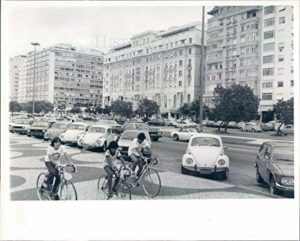 Rio de Janeiro, home to 10 million people, has grown its BRT and public transit in recent years. Many projects were conceived to provide movement for attendees for major sporting events, the FIFA World Cup and the Summer Olympics. Unfortunately, those advances made have not been maintained equally, and many services have declined.
Rio de Janeiro, home to 10 million people, has grown its BRT and public transit in recent years. Many projects were conceived to provide movement for attendees for major sporting events, the FIFA World Cup and the Summer Olympics. Unfortunately, those advances made have not been maintained equally, and many services have declined.
Read more about Rio de Janeiro’s progress here.
 Mexico City, home to 20 million people, has rebuilt since its major 1985 earthquake in ways not ideal for sustainable transport. However, recent investments in cycling and bikeshare, as well as more buses and bus routes have helped the city decrease its reliance on cars.
Mexico City, home to 20 million people, has rebuilt since its major 1985 earthquake in ways not ideal for sustainable transport. However, recent investments in cycling and bikeshare, as well as more buses and bus routes have helped the city decrease its reliance on cars.
Read more about Mexico City here.
 Los Angeles had zero kilometres of rapid transit in 1985. Today it remains a city dominated by car culture, and traffic. But political will is changing with increased awareness about climate change and air quality. Will Los Angeles break with decades of urban policy and embrace sustainable transportation?
Los Angeles had zero kilometres of rapid transit in 1985. Today it remains a city dominated by car culture, and traffic. But political will is changing with increased awareness about climate change and air quality. Will Los Angeles break with decades of urban policy and embrace sustainable transportation?
Read more about Los Angeles here.
 London had 381 kilometers of rapid transit in 1985, more than any other city in this list. Its solid foundation of public transit has allowed the city to enact car reducing policies, like congestion pricing and increase cycling infrastructure. London is an example of how decades of policy can build on one another.
London had 381 kilometers of rapid transit in 1985, more than any other city in this list. Its solid foundation of public transit has allowed the city to enact car reducing policies, like congestion pricing and increase cycling infrastructure. London is an example of how decades of policy can build on one another.
To read a full article about London, click here.
 Jakarta is famous for hours of traffic jams but is now home to the world’s longest BRT, Transjakarta which recently celebrated 1 million passengers in a day. While Jakarta has much to improve, the city is taking seriously the need for sustainable transport.
Jakarta is famous for hours of traffic jams but is now home to the world’s longest BRT, Transjakarta which recently celebrated 1 million passengers in a day. While Jakarta has much to improve, the city is taking seriously the need for sustainable transport.
To read more about Jakarta’s progress and past, click here.
 Guangzhou, like the rest of China, has had an explosion of rapid transit in the past 35 years. However, automobile sales and infrastructure are on the rise for the growing middle class. Can China return to its place as Bicycle Kingdom?
Guangzhou, like the rest of China, has had an explosion of rapid transit in the past 35 years. However, automobile sales and infrastructure are on the rise for the growing middle class. Can China return to its place as Bicycle Kingdom?
Read more about Guangzhou in 1985 and today here.
 Dar es Salaam didn’t even have 1 million residents in 1985 and today is home to over 6 million people and is one of the most rapidly growing cities in Africa. Dar es Salaam won the Sustainable Transport Award in 2016 for its BRT, one of the first in the region.
Dar es Salaam didn’t even have 1 million residents in 1985 and today is home to over 6 million people and is one of the most rapidly growing cities in Africa. Dar es Salaam won the Sustainable Transport Award in 2016 for its BRT, one of the first in the region.
Read more about Dar es Salaam here.
In Chennai the population has increased at about the same rate as its kilometers of rapid transit. While there is public transit available, pedestrian and cycling infrastructure remain weak. Chennai is home to millions of cars and motorcycles and will need more work to provide better mobility options to its residents.
Read more about Chennai here.
 Buenos Aires experienced one of the most dramatic road transformations when it turned a 20 lane road in the middle of the city into a transit corridor with robust pedestrian and cycling infrastructure. While the city does have well functioning public transit systems, there is still more progress to make to serve its residents.
Buenos Aires experienced one of the most dramatic road transformations when it turned a 20 lane road in the middle of the city into a transit corridor with robust pedestrian and cycling infrastructure. While the city does have well functioning public transit systems, there is still more progress to make to serve its residents.
Read more about Buenos Aires transformation here.
For better or worse, the change in these nine cities has been striking. While not all growth and change have been positive, there are positive signs across the globe. As the world rapidly changes, the next years are critical in progress in slowing climate change so that in 35 years we can look back and see more growth and more success.

